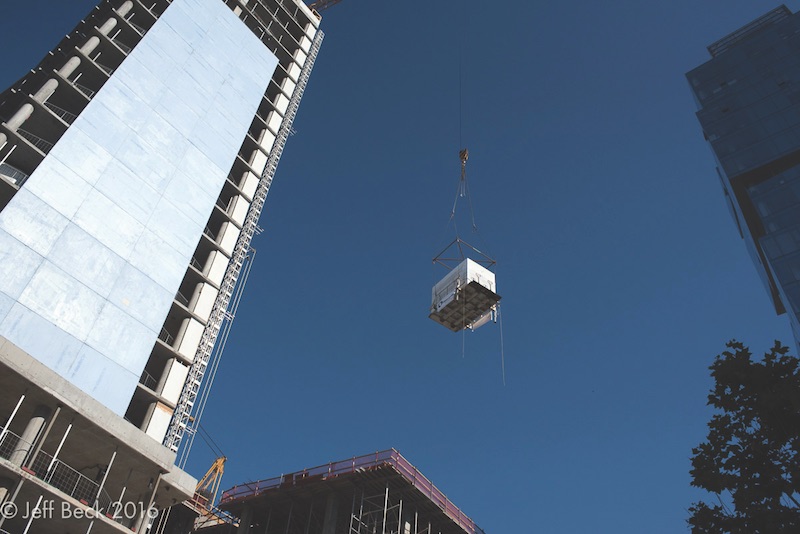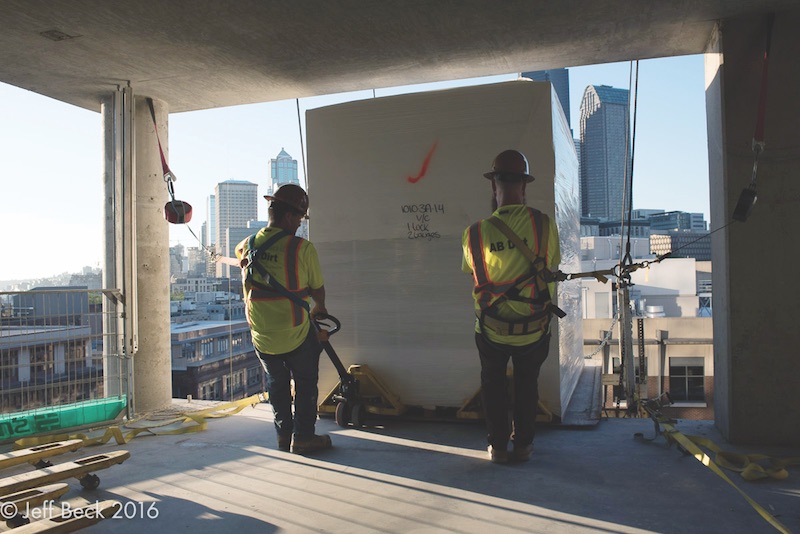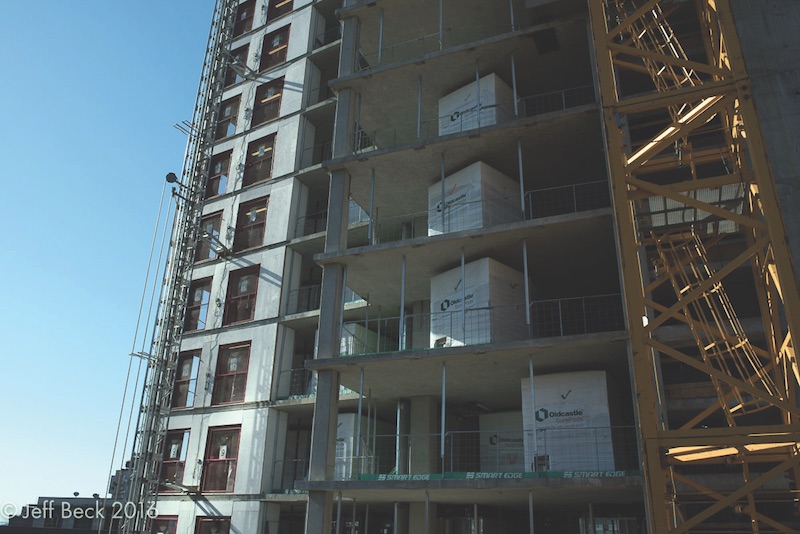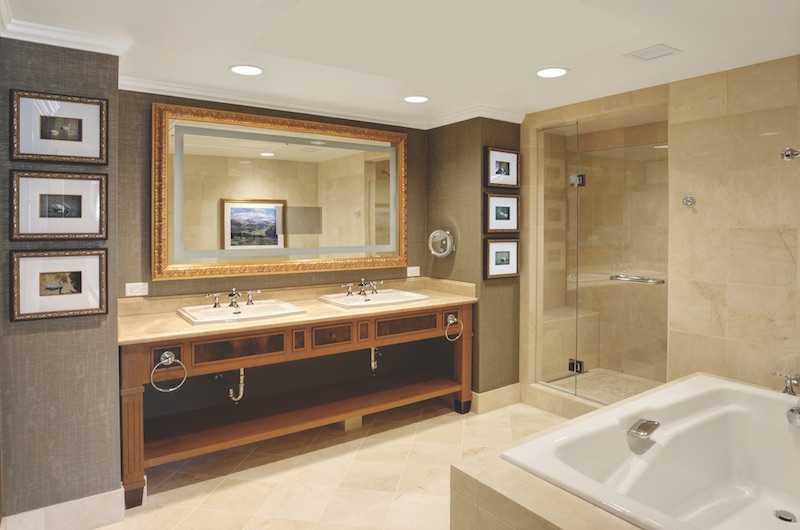There are still hurdles to overcome, but prefabrication techniques are steadily becoming more viable and widespread, as Building Teams realize the potential for labor, schedule, and even cost savings.
In order to receive the full benefits of designing and building with prefabrication techniques, such as bathroom pods, AEC firms should eye projects with repetitive layouts—hotels, student residence halls, in-patient towers, etc. “The more repetition, the more value there is in prefabricating,” says Ray Rigsby, Project Executive with Gilbane Building Co. “Any facility type that has repetitive floor plans lends itself to prefabrication.”
Bathrooms are a particularly good fit for prefabricated construction. Commercial projects such as hotels and student housing typically require large numbers of bathroom units with little or no variation unit to unit. And because bathroom dimensions meet road trucking size limits, the finished product can be shipped to the project site without having to be broken down into multiple components and reassembled on the job site.
(SEE ALSO: New white paper on modular bathroom pods offers insight on best uses)
Bathroom pods have also emerged as a pro tem solution to the construction industry’s ongoing labor shortage. “As a country, we have 1.5 million fewer trades people today than we did in 2007, when we had a similar level of construction activity going on,” says Bill Seery, Managing Director, Oldcastle SurePods, a bathroom pod manufacturer. “This is a structural change in the U.S. construction industry that is never going to go away.”
Rigsby agrees with this sentiment and believes prefabrication provides an answer. “The construction workforce is getting older, there are fewer workers coming into the trades, and there is an overall push to reduce labor costs,” he says. “Prefabrication will be used to offset this trend and in markets that are saturated with work to help offset a lack of workers.”
 Bathroom pods are moved into position at the Seattle Embassy Suites. Jeff Beck, Courtesy Oldcaste SurePods.
Bathroom pods are moved into position at the Seattle Embassy Suites. Jeff Beck, Courtesy Oldcaste SurePods.
Maximizing the Power of Pods
In order to optimize bathroom pods for a given project, the pods need to be incorporated into the design process early—no later than design documents, says Seery. Determine the pod details early—“Reworking details defeats the purpose of prefabrication,” says Rigsby—and start planning with a solid understanding of what the final product will be.
Rigsby and Seery offer additional tips and advice based on their decade-plus career working with prefab construction methods:
- All bathrooms should be the same size and shape. Any slight deviation, other than finishes, requires a new pod template.
- Ensure pod sizes are reflected correctly in the framing details.
- The pod supplier, architect, and contractor should perform a BIM conflict analysis to ensure there are no MEP clashes.
- Factor in site storage options and installation paths for the pods during preconstruction planning. Consider issues related to access to each floor level to allow rigging of the pods.
- Designers should consider the interface between the top of the pod and the ceiling structure to avoid any gaps or misalignment of utilities.
- Make sure all necessary connection points are accessible from the outside.
- Once installed, ensure the pod is squared and plumbed.
The more planning that goes into incorporating bathroom pods, the more beneficial they will be. Based on research and client feedback, Seery estimates that bathroom pods accelerate projects by roughly two months on average.
Rigsby says bathroom pods can also improve quality compared to traditional construction. “The quality control is better, and there are fewer varying conditions in the field and less day-to-day worker variation,” he says.
 The 282-room hotel is scheduled to open this summer. Jeff Beck, courtesy Oldcaste SurePods.
The 282-room hotel is scheduled to open this summer. Jeff Beck, courtesy Oldcaste SurePods.
evolution of the bathroom pod
A decade ago, bathroom pods were constructed with basically the same process as field-built bathrooms, just in a factory setting. Since that time, however, the process has been refined and streamlined.
“We now work natively in Revit for BIM, so we can provide pod models for the architect to drop directly into their building model,” says Seery. “Our Revit models translate directly into machine code for our production robots to produce many of our production pieces, which reduces labor and provides better overall tolerances and accuracy for the pods.”
The products used within the pods have also evolved and improved. SurePods, for example, has created a patent-pending, fully water- and crack-proof ceiling assembly that offers a five-year, no-crack warranty.
Increasingly sophisticated finishes and detailing have expanded the applications for bathroom pods, from suite apartments and dormitories to five-star hotels with complex, five-fixture setups.
“When we started in 2004, the technology to fully automate part of the design-to-manufacturing process did not exist,” says Seery, “nor did some of the more progressive materials we use today.”
 The project’s developer estimates that the use of bathroom pods shaved two months off of the construction schedule. Jeff Beck, courtesy Oldcaste SurePods.
The project’s developer estimates that the use of bathroom pods shaved two months off of the construction schedule. Jeff Beck, courtesy Oldcaste SurePods.
Related Stories
| Jan 3, 2012
New SJI Rule on Steel Joists
A new rule from the Steel Joist Institute clarifies when local reinforcement of joists is required for chord loads away from panel points. SJI members offer guidance about how and when to specify loads.
| Dec 29, 2011
Seismic safety in question at thousands of California public schools
California regulators responsible for enforcing earthquake safety laws have failed to certify more than 16,000 construction projects in California public schools, increasing the risk that some projects may be unsafe, according to a state audit report.
| Dec 27, 2011
State of the data center 2011
Advances in technology, an increased reliance on the Internet and social media as well as an increased focus on energy management initiatives have had a significant impact on the data center world.
| Dec 27, 2011
USGBC’s Center for Green Schools releases Best of Green Schools 2011
Recipient schools and regions from across the nation - from K-12 to higher education - were recognized for a variety of sustainable, cost-cutting measures, including energy conservation, record numbers of LEED certified buildings and collaborative platforms and policies to green U.S. school infrastructure.
| Dec 21, 2011
DOE report details finance options for PV systems in schools
The report examines the two primary types of ownership models used to obtain PV installations for school administrators to use in selecting the best option for deploying solar technologies in their districts.
| Dec 19, 2011
Chicago’s Aqua Tower wins international design award
Aqua was named both regional and international winner of the International Property Award as Best Residential High-Rise Development.
| Dec 16, 2011
Goody Clancy-designed Informatics Building dedicated at Northern Kentucky University
The sustainable building solution, built for approximately $255-sf, features innovative materials and intelligent building systems that align with the mission of integration and collaboration.
| Dec 12, 2011
AIA Chicago announces Skidmore, Owings & Merrill as 2011 Firm of the Year
SOM has been a leader in the research and development of specialized technologies, new processes and innovative ideas, many of which have had a palpable and lasting impact on the design profession and the physical environment.
| Dec 10, 2011
10 Great Solutions
The editors of Building Design+Construction present 10 “Great Solutions” that highlight innovative technology and products that can be used to address some of the many problems Building Teams face in their day-to-day work. Readers are encouraged to submit entries for Great Solutions; if we use yours, you’ll receive a $25 gift certificate. Look for more Great Solutions in 2012 at: www.bdcnetwork.com/greatsolutions/2012.
| Dec 10, 2011
Energy performance starts at the building envelope
Rainscreen system installed at the west building expansion of the University of Arizona’s Meinel Optical Sciences Center in Tucson, with its folded glass wall and copper-paneled, breathable cladding over precast concrete.

















